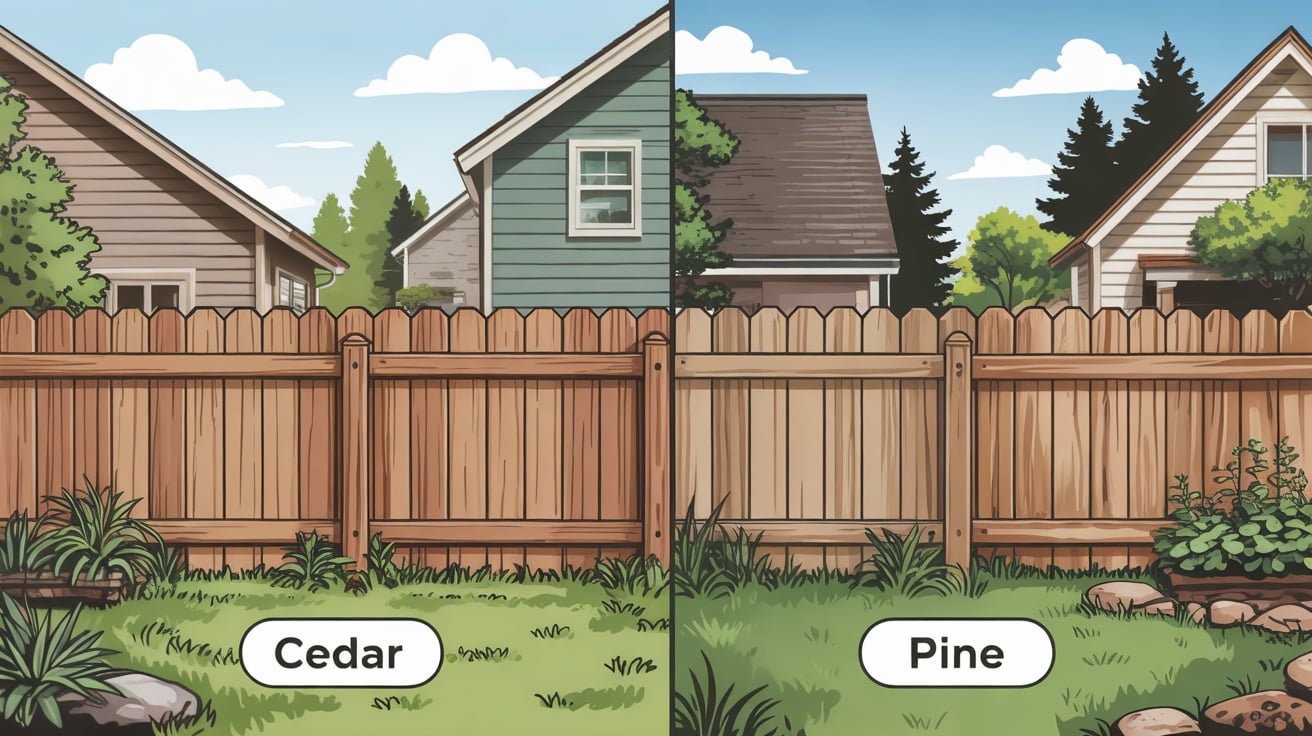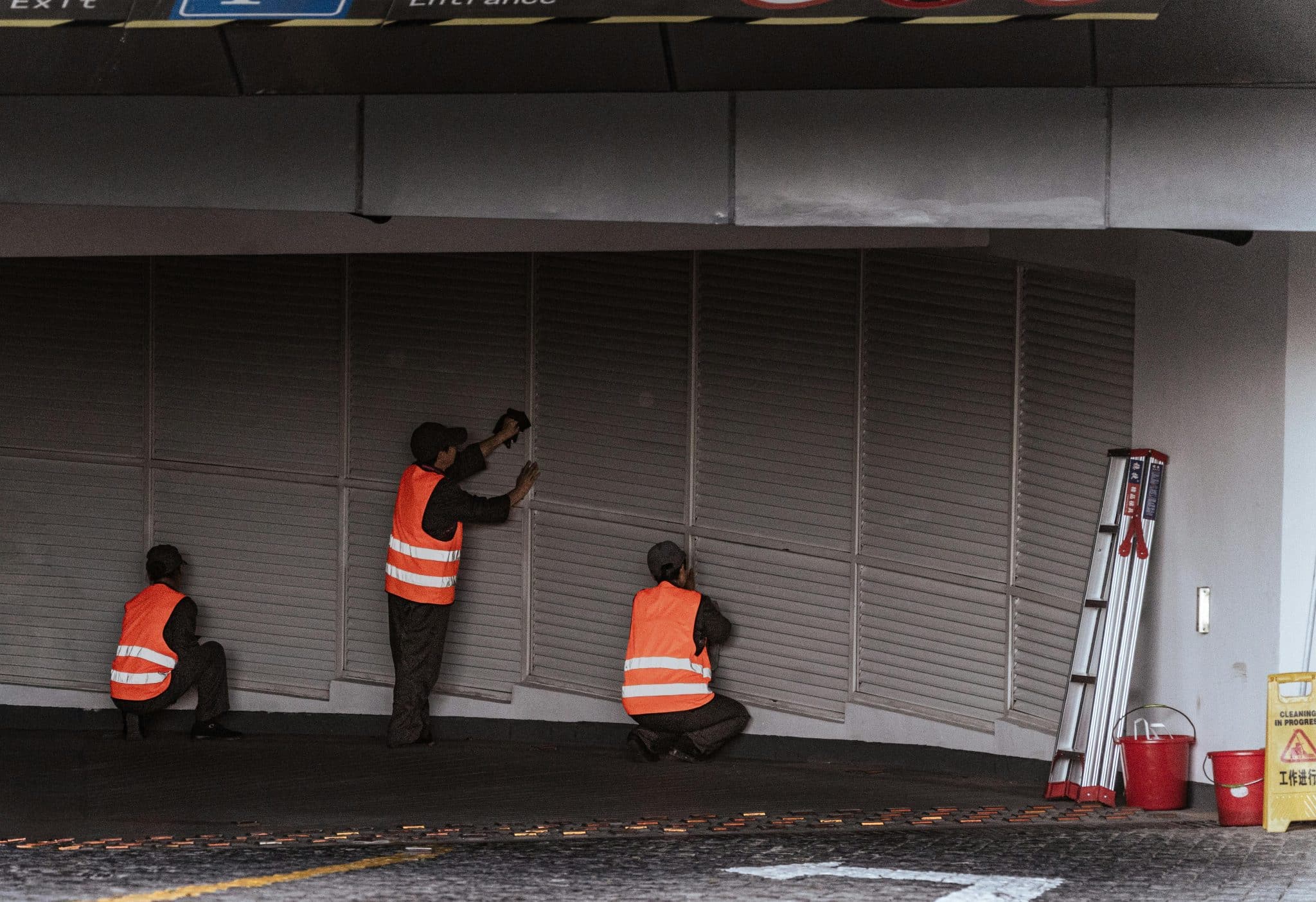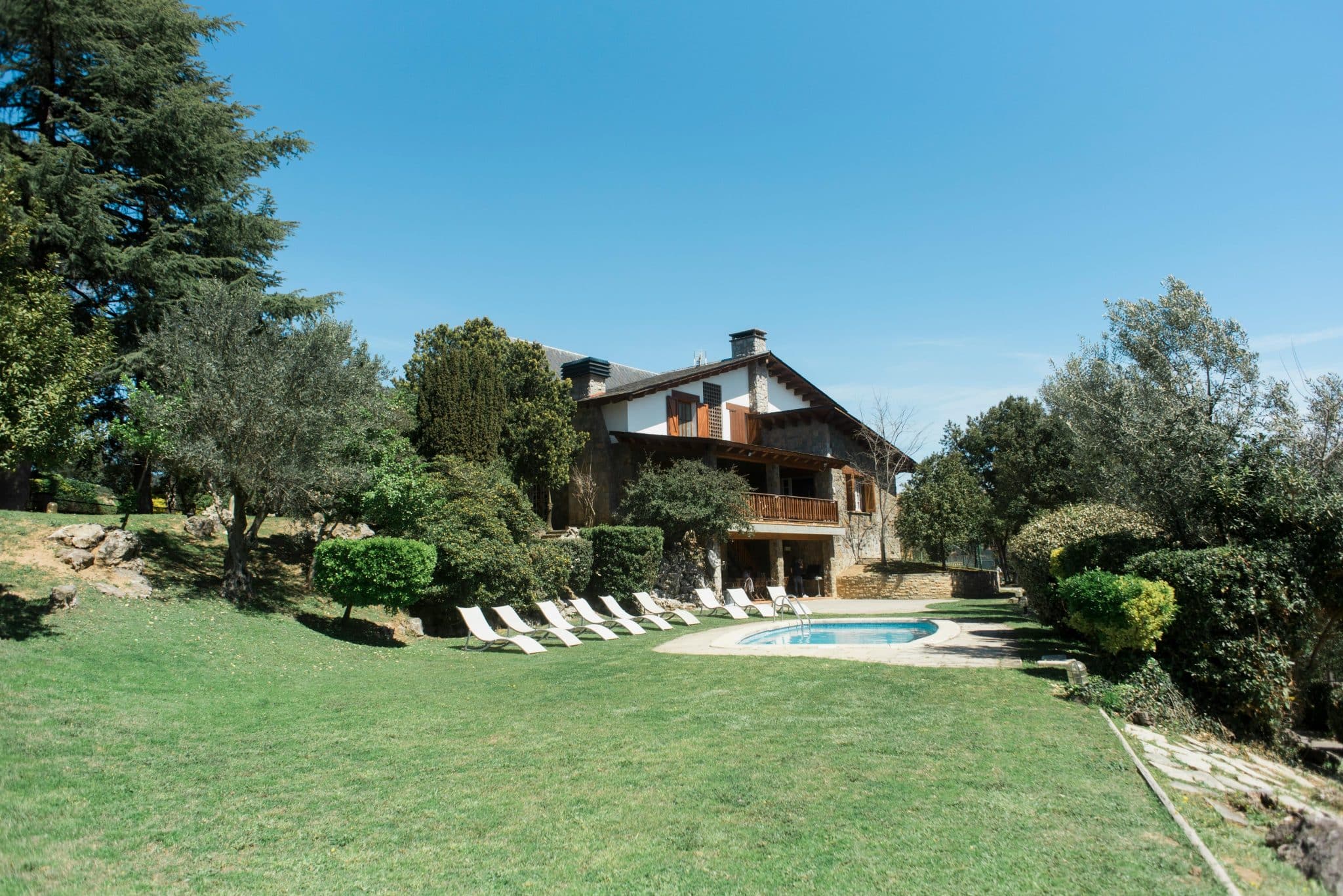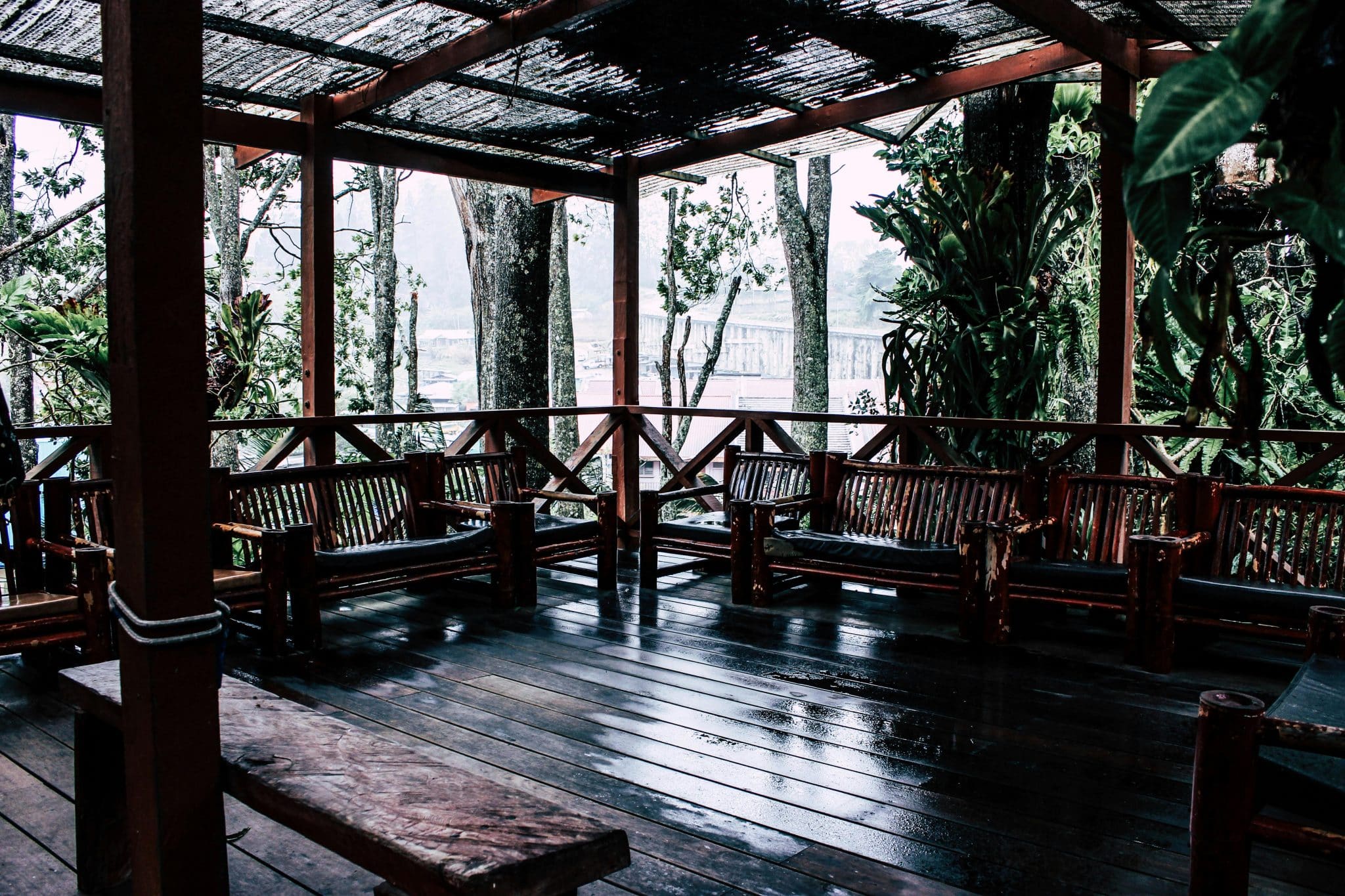Choosing the right wood for a fence can feel like a puzzle with too many pieces.
You want something that looks good, lasts long, and doesn’t empty your wallet. Cedar and pine stand as the two most common options, but figuring out which works best for your home isn’t always clear.
I promise to make this choice simpler by showing you exactly how these woods stack up against each other.
In this guide, I’ll discuss costs, upkeep needs, how long each lasts, and their impact on the environment. I’ll also explain how each option affects your home’s look and what to consider based on where you live.
Cedar vs Pine: The Key Differences
| Feature | Cedar | Pine |
|---|---|---|
| Initial Cost | $15-25 per linear foot | $7-15 per linear foot |
| Lifespan | 15-30 years | 5-15 years (treated) |
| Maintenance Needs | Low – once every 2-3 years | High – yearly treatment |
| Natural Insect Resistance | Yes | No, needs treatment |
| Rot Resistance | Very good | Poor unless treated |
| Weight | Medium-light | Heavier |
| Warping Tendency | Low | Medium to high |
| Staining Ease | Takes stain well | Needs prep work |
| Typical Warranty | 10-20 years | 5-10 years |
| Weather Resistance | Handles rain and sun well | Crack in hot, dry areas |
| Environmental Rating | Better – often from managed forests | Depends on treatment type |
Maintenance Requirements: How much time and money you’ll spend on upkeep varies between these woods. Pine needs more care, while cedar can often stand on its own with less work.
Longevity and Warranty: Your fence’s lifespan matters for long-term value. Cedar tends to last longer without help, while pine may need extra care to reach the same age.
Environmental Impact: Both woods affect nature in different ways, from how they’re grown to how they’re treated before they reach your yard.
Cedar Fencing: Benefits, Drawbacks, and Features
Cedar has earned its place as a top choice for fences across the country. Let’s examine what makes this wood worth considering for your property.
Benefits of Cedar Fencing
Cedar offers several advantages that make it a favorite among homeowners and builders:
- Natural resistance to insects – Cedar contains oils that repel termites, ants, and other wood-boring pests without chemical treatments
- Built-in rot resistance – The same natural oils help cedar withstand moisture and resist decay, even in wet climates
- Attractive appearance – The rich, warm tones and clean grain pattern give cedar a high-end look
- Dimensional stability – Cedar tends to stay straight and resist warping or twisting over time
- Ages well – If left untreated, cedar weathers to a distinguished silver-gray that many find attractive.
Drawbacks of Cedar Fencing
- Higher initial cost – Expect to pay roughly twice as much as pressure-treated pine for cedar fencing
- Variable quality – The wide range of cedar grades means some lower-grade options may not perform as well
- Color fading – Without regular treatment, the rich color will naturally gray over time (though some prefer this look)
- Not completely maintenance-free – While low-maintenance, cedar still benefits from cleaning and occasional treatment
- Less available in some regions – Areas distant from cedar forests may face higher costs due to shipping
Key Features of Cedar Fencing
What makes cedar unique among fencing woods:
- Natural oils (thujaplicins) that provide biological protection without added chemicals
- Low-density wood structure that creates natural insulation properties
- Straight grain pattern that helps boards remain stable through seasonal changes
- Aromatic properties that many find pleasant and may help repel some insects
- Sustainability potential when sourced from responsible forestry operations
Pine Fences: Pros, Cons, and Applications
Pine fencing remains a popular choice for many homeowners looking for a functional barrier that won’t break the bank. Here’s what you should know about pine as a fencing material.
Pros of Pine Fencing
- Cost-effectiveness – Pine typically costs 40-60% less than cedar, making it budget-friendly for large projects
- Wide availability – Found in most lumber yards and home centers with a consistent supply
- Accepts treatments well – Pine readily absorbs pressure treatments that extend its lifespan.
- Easy to work with – Softer wood makes cutting, drilling, and nailing simpler during installation.
- Takes paint beautifully – If you want a colored fence, pine holds paint well for a smooth finish.
Cons of Pine Fencing
- Requires chemical treatment – Untreated pine will rot and attract insects within 1-3 years
- Tendency to warp – Pine is more likely to twist, cup, or bow as it ages and dries
- Knots can weaken boards – The numerous knots in pine can create weak points in the wood
- Shorter lifespan – Even treated pine typically lasts only 5-15 years compared to cedar’s 15-30
- Ongoing maintenance needs – Requires more frequent staining, sealing, or painting
Common Applications for Pine Fencing
- Budget-focused projects where initial cost matters more than longevity
- Large property boundaries where using premium woods would be prohibitively expensive
- Temporary or transitional fencing that isn’t intended to last decades
- Painted fence designs where the natural wood grain won’t be visible anyway
- Farm and ranch fencing covering extensive areas
What Are Fence Wood Grades?
Wood grades tell you about the quality of lumber pieces. Grading looks at knots, grain patterns, splits, and other marks on the wood. Higher grades have fewer flaws and more even grain.
Lower grades have more knots and natural marks. Grades differ between wood types, with cedar and pine using different systems. Knowing these grades helps you pick the right wood for your fence.
1. Clear Grade vs Knotty Grade Cedar
| Feature | Clear Grade Cedar | Knotty Grade Cedar |
|---|---|---|
| Appearance | Few or no knots, even grain | Many knots, varied grain patterns |
| Cost | 30-50% more expensive | More budget-friendly |
| Strength | More consistent, fewer weak points | May have weak spots near knots |
| Ideal Use | Front yard, visible areas | Backyard, rural properties |
| Warping Risk | Lower chance of warping | Higher chance of warping |
| Visual Appeal | Clean, formal look | Rustic, natural look |
2. Premium vs Standard Pressure-Treated Pine
| Feature | Premium PT Pine | Standard PT Pine |
|---|---|---|
| Moisture Content | Kiln-dried after treatment | Often still wet when sold |
| Straightness | Straighter boards, less warping | More likely to warp as it dries |
| Knot Count | Fewer knots | More knots |
| Surface Finish | Smoother surface | Rougher, may need sanding |
| Chemical Retention | More even treatment | Sometimes uneven treatment |
| Price Difference | 15-25% more expensive | Basic price point |
| Best For | Visible areas, longer-term fences | Budget projects, shorter-term use |
Factors That Affect Fence Longevity
1. Exposure to Sunlight and Rain
- UV Damage: Constant sunlight breaks down wood fibers and fades colors, with south and west-facing fences aging faster than those in the shade.
- Water Cycles: Repeated wetting and drying cause wood to expand and contract, leading to cracks and splits over time.
- Rain Runoff: How water flows around your fence matters; poor drainage keeps the wood wet longer and speeds up rot in both cedar and pine.
2. Soil Conditions and Ground Contact
- Soil Moisture: Wet, poorly drained soil will cause fence posts to rot faster, with clay soils holding more moisture against the wood than sandy soils.
- Soil pH Levels: Very acidic or alkaline soils can break down wood and metal fasteners more quickly than neutral soils.
- Post Depth: Posts placed too shallow in the ground move more with wind and frost heaves, loosening them over time and causing fence failure.
3. Proper Installation Practices
- Post Setting Method: Concrete footings create a water trap if not installed correctly, while gravel-based footings allow better drainage around the wood.
- Hardware Quality: Using galvanized or stainless-steel fasteners prevents rust streaks and premature board failure from nail or screw corrosion.
- Spacing Considerations: Proper gaps between boards and adequate post spacing create room for wood expansion, preventing warping and buckling.
Sustainability Chart: Cedar vs Pine Fence
🔵 Fast Growth & Renewable (pine): ██████████████░░░░░░ 30%
🟢 Chemical-Free & Durable (cedar): ██████████████░░░░░░ 30%
🟡 Pressure Treatment Impact (pine): █████████░░░░░░░░░░░ 20%
🟣 Recyclability & Safe Disposal (Cedar): █████████░░░░░░░░░░░ 20%
Popular Fence Styles Using Cedar and Pine
1. Privacy Fence Styles
Privacy fences create a solid barrier around your yard, typically standing 6-8 feet tall. They work well in both woods:
Board-on-Board: Overlapping boards create a fence with no gaps from either side. Cedar’s stability makes this style last longer without warping.
Solid Panel: Full panels with no gaps between boards offer complete privacy. Pine’s lower cost makes this style more affordable for large areas.
Shadowbox: Boards alternate on opposite sides of the fence rails, creating the same look from both sides. This style uses more wood but looks great in either material.
2. Picket Fence Designs
Picket fences offer charm with less privacy, usually standing 3-4 feet tall:
• Classic Pointed Pickets: The timeless design with pointed tops works in both woods, though cedar holds the crisp points longer without wear.
• Flat-Top Pickets: Modern and clean-looking, these work well in pine as the simple cuts are easy to maintain.
• Scalloped or Curved Designs: These more complex patterns show off craftsmanship and look stunning in cedar, which holds detailed cuts well.
3. Horizontal vs Vertical Boards
The direction of your fence boards creates very different looks:
• Horizontal Boards: Create a modern, sleek look that makes spaces seem wider. Cedar is often preferred here as it resists sagging better over long spans.
• Vertical Boards: The traditional approach sheds water better and uses shorter boards. Pine works well here as any warping is less noticeable in vertical installation.
• Mixed Directions: Some modern designs use both horizontal and vertical elements. This works well with either wood but looks especially good with cedar’s richer color variation.
Conclusion
Now you know the key facts about cedar and pine fencing. Cedar offers natural bug resistance and needs less care, but it costs more upfront.
Pine gives you a budget-friendly option that works well with proper treatment and regular upkeep.
Your local weather, soil type, and how you install your fence all play big roles in how long it will last. Think about what matters most to you: initial cost, long-term care, or how it looks as it ages.
No matter which wood you pick, good installation makes all the difference. Set posts at the right depth, use quality hardware, and plan for proper drainage.
Remember that your fence is both a practical item and a key part of your home’s outer look. Choose the wood that fits your needs, budget, and style.












